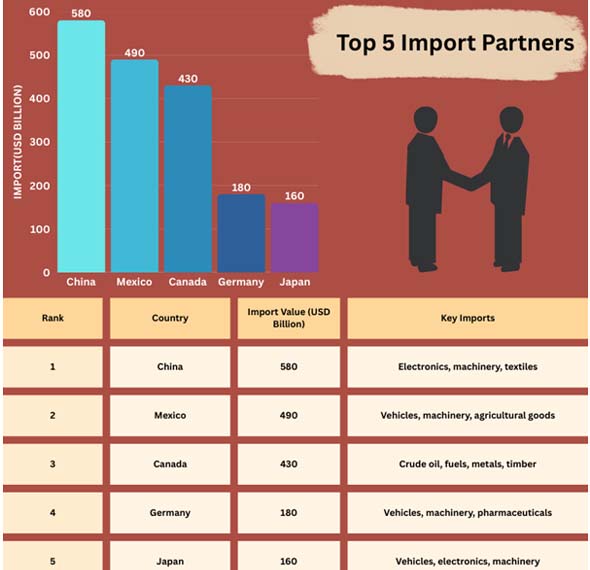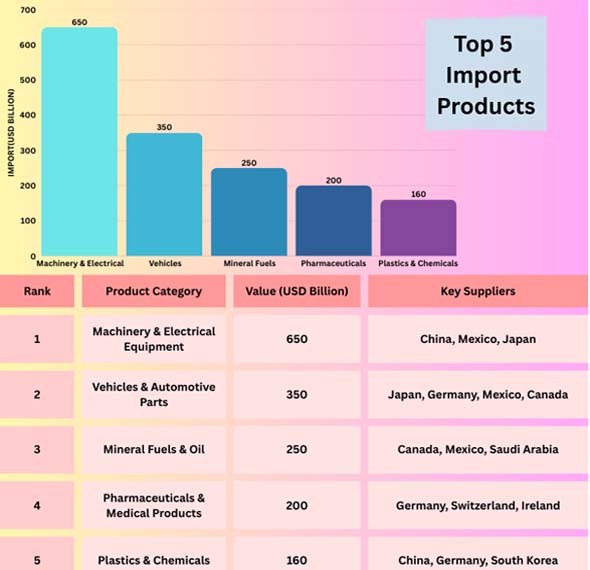
- Nov 04, 2025
A Detailed Look at the USA's Top 5 Import Partners and Products
The US is not only the biggest economy in the world, but it also buys the most goods and services from other countries.
The country has a GDP of more than $27 trillion and depends on commerce with other countries to fulfill consumer demand, keep businesses going, and stay ahead in technology. As per USA Import Data by Import Globals, imports are very important for making sure that American customers may get cheap items, cutting-edge technology, and important resources that might not be easy to find in the US.
The U.S. import market is quite varied. It includes everything from high-tech gadgets and cars to crude oil, medicines, and common items. This dependence is due to both the size of the U.S. economy and the fact that current global supply chains are all linked together. Based on USA Export Data from Import Globals, to have a clearer idea of America's trade situation, it's important to look at its five biggest import partners and its five biggest import items. These insights show not only how dependent the country is on trade, but also the chances and hazards that may affect future trade policy.
The USA's Top Five Trading partners

1. China, the giant of Manufacturing
China is still the biggest partner for U.S. imports. It sends a lot of different types of manufactured products, such as electronics, textiles, toys, and machinery. According to China Import Export Trade Data, China is responsible for around 16–17% of all U.S. imports, which are worth more than $580 billion a year. The agreement shows that China is the world's factory, able to make a lot of things at once and for less money.
According to China Import Data by Import Globals, China's innovative manufacturing environment keeps it on top, even if there are still trade conflicts, taxes, and attempts to move supply chains. For U.S. stores, whether they're software businesses or clothing labels, China is still very important. But this reliance also makes people worry about the safety of the supply chain, especially during times of geopolitical instability or major global events like the COVID-19 epidemic.
2. Mexico — Close by and part of the same System
Mexico is the second-largest country where the United States buys things. Every year, items worth more than $490 billion flow north. About 14% of all U.S. imports come from it. Mexico is important since it is close to the US and Canada and is part of the USMCA (United States-Mexico-Canada Agreement).
Mexico Import Trade Analysis by Import Globals states, Mexico's main exports to the U.S. include cars, car parts, electronics, equipment, and food. Many U.S. companies, especially those in the automotive and electronics sectors, depend on Mexico for just-in-time supply chains. Cross-border trade is becoming more and more efficient, making Mexico a better choice than Asian supply chains, especially as corporations aspire to "nearshore" operations.
3. Canada: A Reliable Source of Resources
Canada is another important partner, sending over $430 billion worth of goods to the U.S. every year, which is about 12% of all U.S. imports. Canada's natural resources are what make it strong. The main things that are traded are crude oil, natural gas, mineral fuels, lumber, and metals. Canada sends more than just resources to the U.S.; it also sends cars and machines.
Because the U.S. and Canada share a border, have modern infrastructure, and depend on each other for energy, this trade relationship is very good for the U.S. As per Canada Export Data, Energy imports from Canada keep the U.S. market stable and safe, and other items help businesses in fields like construction and technology.
4. Germany: The Industrial Heart of Europe
As per Germany Import Data, Germany is the fourth-largest U.S. import partner, sending more than $180 billion worth of goods to the U.S. each year, or roughly 5% of all U.S. imports. Germany is known for being an industrial powerhouse, and this is shown by the fact that it exports cars, high-end machinery, drugs, and precise tools.
In the U.S., there is a huge demand for luxury automobile brands like BMW, Mercedes-Benz, and Audi. German machinery also helps U.S. manufacturing become more modern. Germany is also important to the pharmaceutical industry since many life-saving medications and cutting-edge medical technology come from German businesses.
5. Japan: Great at technology and Cars
Japan sends the U.S. items worth more than $160 billion a year, which is about 4.5% of all U.S. imports. Most of these imports are cars, car parts, and high-tech equipment. As per Japan Import Trade Statistics by Import Globals, Japanese businesses are known for being creative, efficient, and manufacturing high-quality goods. This makes them good trading partners.
Japanese imports are very important to the U.S. car sector, while consumer electronics and specialist machinery are also quite important. Japan's focus on quality fits nicely with what American businesses and consumers require.
The USA's Top 5 Imports

1. Machinery and electrical equipment (HS 84)
This is the biggest category of imports, worth more than $650 billion a year, or around 19% of all imports. As per USA Import Data by Import Globals, it has computers, semiconductors, telecommunications equipment, and machines used in factories. The U.S. IT and industrial industries would have a hard time staying competitive without these imports.
Most of these imports originate from China, Mexico, Japan, and South Korea. Microchips and semiconductors are extremely important since they are the building blocks of contemporary electronics, AI, and defensive technologies.
2. Cars and car parts (HS 87)
This group makes up around 10% of U.S. imports and is worth more than $350 billion. It has automobiles, trucks, commercial vehicles, and parts for autos. Imports from Japan, Germany, Mexico, and Canada are very important to the U.S. car sector.
As per USA Import Export Trade Analysis, Most automobiles on American roads are imported, but auto parts are needed to put together and fix cars made in the US. This industry shows how well-connected the world's automotive supply chains are.
3. Oil and mineral fuels (HS 27)
The U.S. imports more than $250 billion worth of crude oil and refined petroleum, even though it is a major oil producer. These imports make up roughly 7% of all imports. Saudi Arabia is the next biggest provider, behind Canada and Mexico.
When it comes to energy imports, it's not only about getting enough; it's also about making sure the refineries can handle it. Some U.S. refineries are designed to work best with certain types of crude oil that can't always be produced in the U.S.; therefore, imports are needed.
4. Medical Products and Pharmaceuticals (HS 30)
The U.S. healthcare system is one of the biggest in the world, and it relies heavily on drugs that cost more than $200 billion a year to import. Most of the things in this category come from Germany, Switzerland, and Ireland.
As per USA Export Import Global Trade Data, imported pharmaceuticals ensure that Americans can get world-class medical care, from vaccinations and antibiotics to the latest cancer therapies. The COVID-19 pandemic showed how important pharmaceutical imports are, as making sure that necessary medications are available became a global concern.
5. Chemicals and Plastics (HS 39 and 29)
Another important group is plastics and chemicals, which are valued at more than $160 billion. They are utilized in many fields, including textiles, packaging, car manufacturing, and consumer products. A lot of the goods come from China, Germany, and South Korea.
Many of these imports are used by customers, but they are also important for U.S. makers who need them to make things.
How important U.S. imports are for National Security
As per USA Import Export Global Data, they help firms receive high-tech parts, keep the energy supply stable, and satisfy the demands of health care professionals. Without imports, businesses like cars, planes, and drugs would have a hard time staying as big as they are now.
Imports also assist keep costs stable in the country. People don't spend as much because goods from other countries, especially China and Mexico, are cheaper. This is a direct way that imports affect the ability of American families to buy things.
Problems and the Way Ahead
It's hard for the U.S. because it depends on supplies. More and more important things, like drugs, microchips, and rare-earth elements, are being asked to be made in the US by powerful people.
Powerful people want more and more important things to be made in the US, like drugs, microchips, and rare-earth elements. To spread the risks, the U.S. is also getting goods from more countries, like Vietnam, South Korea, and India.
Long term, the U.S. will figure out how to get things from other countries while also putting money into its own. To do this, it will try to find a balance between cost, effectiveness, and durability.
Last Thoughts
The trade network of the United States shows how difficult the world economy is. There are many important supply lines that connect the U.S. economy to those around the world. These include partners like China, Mexico, Canada, Germany, and Japan; as well as important goods like drugs and tools.
The U.S. is the biggest importer in the world, thus it sets the tone for commerce across the world. Even while there are still problems like geopolitical conflicts, its import system makes sure that American businesses and consumers have access to the greatest resources, technology, and goods from around the world. Import Globals is a leading data provider of USA Import Export Trade Data.
FAQs
Que. Who is the USA's biggest trading partner?
Ans. China is the biggest partner for imports, sending more than $580 billion worth of technology, industrial, and consumer items each year.
Que. What is the most common thing that people buy in the US?
Ans. The biggest group of things we buy from other countries is machines and electrical equipment, such as computers and semiconductors.
Que. Why does the U.S. import oil from other countries?
Ans. It imports oil to meet the needs of its refineries and keep the supply stable.
Que. What is the total amount of goods that the U.S. imports each year?
Ans. The U.S. was the biggest importer in the globe in 2024, bringing in more than $3.5 trillion worth of commodities.
Que. Where can you find precise USA Import Data?
Ans. For additional information on current statistics, go to www.importglobals.com or send an email to info@importglobals.com.
